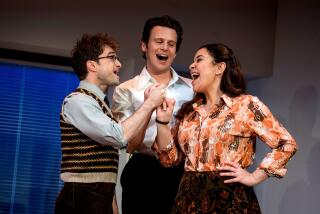Review: In the deeply felt ‘Blues in the Night,’ stellar songs speak for themselves
Theatrical productions that focus on pop music too often struggle against what I’ve come to think of as “sitcom syndrome.”
That’s where the show’s creators attempt to frame a series of songs, usually beloved hits, within an invented story that introduces characters, injects conflict and ultimately resolves everything with a feel-good ending — like an episode of “Happy Days.”
Sitcom syndrome has been the downfall, at least for this lifelong pop music fan, of “Memphis,” “Motown the Musical” and “The Million Dollar Quartet,” among others.
I’m happy to report a new production of Sheldon Epps’ 1980 show “Blues in the Night,” now at the Wallis Annenberg Center for the Performing Arts’ intimate Lovelace Studio Theater in Beverly Hills, largely avoids sitcom syndrome by pretty much doing away with such plot conceits.
Instead, it simply, and satisfyingly, serves up a full slate of blues and jazz numbers from the 1920s and ’30s. They are convincingly delivered by a quartet of singers who are backed by a sharp live jazz quintet that delivers the songs in smart arrangements.
Epps, whose 20-year tenure as artistic director of the Pasadena Playhouse drew to a close last year, directs this revival of the show with which he made his off-Broadway directorial debut almost four decades ago.
It examines the intersection of the blues and jazz through more than two dozen songs written by such formidable talents as Bessie Smith, Ida Cox, Alberta Hunter, Duke Ellington, Harold Arlen, Johnny Mercer, Benny Goodman and Billy Strayhorn.
More than a revue but well short of a conventional book musical, “Blues in the Night” was inspired by a quote Epps came across from the great jazz singer and songwriter Billie Holiday, who once observed that “Blues is to jazz what yeast is to bread.”
That’s about all an audience needs to know going in to this show, which speaks, or rather sings, for itself. It plays out on a cozy, well-patinaed triptych stage, designed by John Iacovelli and bathed in Jared A. Sayeg’s lighting design that favors hues of deep blue.
Within these three apartment/hotel rooms, under the glowing red neon sign of a neighboring jazz club, the myriad emotions and moods the blues can communicate are explored by three female characters: the Lady From the Road (Yvette Cason), the Girl With the Date (Bryce Charles) and the Woman of the World (Paulette Ivory), who take turns interpreting, and collaborating on, the songs.
In essence, they’re welcoming the audience into their boudoirs, an intimacy that echoes the access these songs provide into the innermost reaches of the heart.
There’s also a male character, the Man in the Saloon (Chester Gregory), who personifies the romantic hopes and dashed dreams of the women who are sharing their deepest feelings through music.
The emotional centerpiece of “Blues in the Night” is a half-dozen songs written and originally recorded by Smith, the one-time Empress of the Blues, the elemental African American song form that quickly was adopted and adapted by jazz musicians and composers.
Epps once again has wisely tapped Cason, who costarred in last year’s Pasadena Playhouse production of “Shout, Sister, Shout,” the musical about the life and music of gospel singer-guitarist Sister Rosetta Tharpe.
Here, she applies her full-throated voice to Smith’s songs, beginning with “Blue Blues,” which opens the show’s first act on a downhearted note that even the most casual listener will identify as quintessential blues.
Cason has vocal chops to burn, applying them later to double-entendre-laden songs expressing the lustier side of the blues, among them Leola and Wesley Wilson’s “Take Me for a Buggy Ride” and Andy Razaf and Wesley Wilson’s saucy “Kitchen Man.”
Ivory easily handles the challenge in Strayhorn’s classic ballad of disillusionment “Lush Life,” marrying near-operatic purity of tone from her dark mezzo-soprano with a jazz-blues singer’s mastery of behind-the-beat phrasing.
It’s one of the show’s two most powerful performances, the other being Cason’s all-in rendition of Smith’s harrowing “Wasted Life Blues” late in the second act.
Charles gets some of her own sad moments to revel in, but she often brings precocious, spunky counterbalance to the wizened personas of her two female foils, who often join with her in different duet combinations and periodic full trio arrangements.
Music director Abdul Hamid Royal has supplied one of his most evocative arrangements to Charles with his treatment of Ann Ronell’s “Willow Weep for Me,” which she sings into a telephone as lonely piano and bass notes toggle hauntingly under the despairing melody.
Gregory deftly handles comic relief duties with his preening peacock character, offering up Ida Cox’s “Wild Women Don’t Have the Blues” as his antidote to the frequent disappointment given voice by the show’s women.
Epps’ show first and foremost aims to share the deeply communicative power of the blues with contemporary audiences who may be less familiar with its rich and robust history.
Even so early in his career, Epps obviously understood that with songs as powerfully expressive as these, no silly stories are required.
♦ ♦ ♦ ♦ ♦ ♦ ♦ ♦ ♦ ♦
‘Blues in the Night’
Where: Lovelace Studio Theatre, Wallis Annenberg Center for the Performing Arts, 9390 N. Santa Monica Blvd., Beverly Hills
When: 8 p.m. Tuesdays-Fridays, 2:30 and 8 p.m. Saturdays, 2:30 and 7:30 p.m. Sundays; extended through May 27
Tickets: $65
Info: (310) 746-4000 or www.TheWallis.org
Running time: 2 hours (including intermission)
Follow @RandyLewis2 on Twitter.com
For Classic Rock coverage, join us on Facebook
MORE THEATER:
David Henry Hwang and Jeanine Tesori on bringing their latest to the stage
Why an Asian cast remains a radical idea for American theater
Tony Award nominations 2018: The complete list
More to Read
The biggest entertainment stories
Get our big stories about Hollywood, film, television, music, arts, culture and more right in your inbox as soon as they publish.
You may occasionally receive promotional content from the Los Angeles Times.






